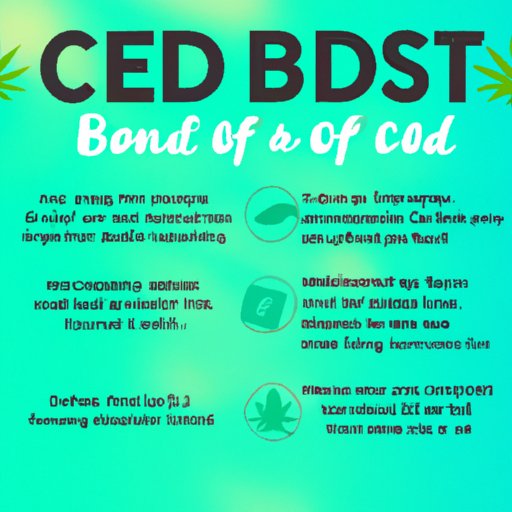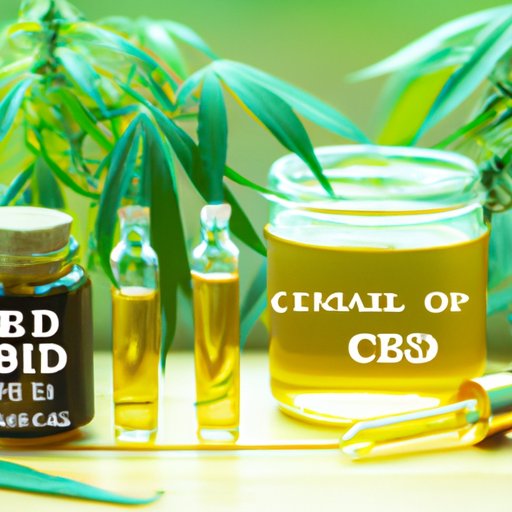Introduction
Cannabidiol, or CBD, has become increasingly popular in recent years due to its numerous health benefits. CBD is one of the many natural compounds found in hemp and cannabis plants, but it doesn’t cause the “high” associated with THC. In this article, we’ll provide a comprehensive guide on how CBD is made, different types of CBD products available, health and safety considerations, history of CBD, and benefits and side effects.
A Step-by-Step Guide to Making CBD
The process of making CBD can be broken down into several steps:
Harvesting the Hemp Plant
CBD is extracted from hemp plants, which are harvested when the flowers are fully developed and the resin glands are mature. This typically occurs 4-6 months after planting the seeds.
Drying and Curing the Hemp Plant
The harvested hemp plants are then dried and cured to remove excess moisture and preserve the quality of the cannabinoids. This process can take up to a week.
Extraction Methods
There are several ways to extract CBD from the hemp plant:
CO2 Extraction
CO2 extraction is the most commonly used method for producing high-quality CBD oil. This method uses pressurized carbon dioxide to pull CBD and other phytochemicals from the plant material. The result is a CBD oil that is free from solvents and other impurities.
Solvent Extraction
Solvent extraction involves using a solvent such as ethanol or butane to extract the CBD from the plant material. While this method is less expensive than CO2 extraction, it’s also more likely to leave behind impurities and solvent residue.
Olive Oil Extraction
Olive oil extraction is a simple and safe method for producing CBD oil at home. The process involves heating the hemp plant in olive oil to extract the CBD and other cannabinoids. However, this method isn’t as efficient as CO2 extraction for producing high-quality CBD oil.
Refining the Extracted Oil
After the CBD has been extracted, it’s usually further refined to remove any remaining impurities. This can involve filtering the oil to remove plant matter, or using a process called winterization to remove fats and waxes.
Testing the CBD Oil for Quality and Potency
Once the CBD oil has been extracted and refined, it’s important to test it for quality and potency. This can include testing for THC content, as well as checking for contaminants such as pesticides and heavy metals.
Product-Focused: Types of CBD Products and How They Are Made
There are several different types of CBD products available, each made using a different process. Here are some of the most common types of CBD products:
CBD Oils and Tinctures
CBD oil and tinctures are liquid extracts that are taken sublingually (under the tongue). They are made by infusing CBD into a carrier oil such as MCT oil or hemp seed oil. Flavors can also be added to make the oil more palatable.
Extraction Methods
As mentioned, CO2 extraction is the most common method for producing high-quality CBD oil. This ensures that the final product is free from impurities and solvents. However, some manufacturers may use other extraction methods, which can affect the quality of the oil.
Adding Flavors and Carrier Oils
To make the oil more palatable, flavors such as peppermint or vanilla may be added. The oil is also usually mixed with a carrier oil such as MCT oil or hemp seed oil to dilute the CBD and make it easier to absorb.
Edibles
Edibles are food items that are infused with CBD. They can include gummies, chocolates, or even CBD-infused coffee. Edibles are made by infusing CBD into the food item using a process similar to the one used to infuse THC into edibles.
Infusing CBD into Food and Drinks
To infuse CBD into a food item, the CBD oil is typically mixed into the recipe. This can be done by adding the oil to a melted chocolate mixture, for example, or by stirring the oil into a smoothie.
Popular Types of Edibles
Some of the most popular types of CBD edibles include gummies, chocolates, and baked goods such as brownies or cookies. These items can be found online or at local dispensaries.
Topicals
Topicals are CBD-infused lotions, balms, and salves that are applied directly to the skin. They are used for localized relief and are not typically absorbed into the bloodstream.
Infusing CBD into Lotions, Balms, and Salves
Topicals are made by infusing CBD into a base such as coconut oil or shea butter. Other ingredients such as essential oils may also be added to provide additional benefits. The resulting product can be applied directly to the skin.
How Topicals Work and Their Benefits
Topicals provide localized relief for a variety of conditions, including muscle soreness, arthritis, and eczema. They work by binding to the CB2 receptors in the skin, reducing inflammation and promoting healing.
Health and Safety Considerations in CBD Production and Manufacturing
Manufacturing CBD involves several health and safety considerations:
Regulations and Standards Manufacturers Must Satisfy to Ensure Safety
Manufacturers must comply with FDA regulations and adhere to strict quality standards to ensure the safety and purity of their products. They must also comply with state cannabis regulations, which can vary widely depending on the state.
Concerns Around Contamination and Proper Storage of CBD
Contamination can occur at any point during the CBD manufacturing process, from growing the hemp to processing the final product. Proper storage is also important to prevent degradation of the CBD over time.
Differences in Quality Between CBD Products Made in Regulated and Unregulated Environments
CBD products made in regulated environments are typically of higher quality and are more likely to be free from contaminants. Products made in unregulated environments may not undergo the same quality control measures.
The History of CBD
The use of cannabis for medicinal purposes dates back thousands of years, but the discovery of CBD is a more recent development:
Cannabis Use in Ancient Civilizations
Cannabis was used for medicinal and spiritual purposes in ancient civilizations such as China and India. It was also used recreationally in some cultures.
The Discovery of the Cannabis Plant and Its Components
In 1963, the chemical structure of CBD was first identified by Israeli scientist Raphael Mechoulam. This discovery led to increased interest in the compound and its potential medicinal uses.
Legislative Changes and Medical Research That Led to Increased Interest in CBD as a Medicinal Option
Over the past decade, several states have legalized the use of medical marijuana and CBD, leading to more research on the potential health benefits of the compound. CBD has been found to be effective in treating a variety of conditions, including epilepsy, anxiety, and chronic pain.

Benefits and Side Effects of Using CBD
While CBD has several potential health benefits, it’s important to be aware of the possible side effects:
Pain Relief and Other Benefits
CBD has been found to be effective in reducing pain, inflammation, and anxiety. It may also have neuroprotective properties and could be useful in treating epilepsy and other neurological disorders.
Possible Side Effects
The most common side effects of CBD include dizziness, nausea, and fatigue. CBD can also interact with some medications, so it’s important to talk to your doctor before using CBD if you’re taking any prescription medications.
Real-Life Experiences of CBD Users
Many people have found relief from a variety of conditions by using CBD. However, it’s important to remember that everyone’s experience with CBD is different, and what works for one person may not work for another.
Conclusion
In conclusion, CBD is a natural compound that has numerous health benefits. There are several different types of CBD products available, each made using a different process. It’s important to consider health and safety considerations in CBD production and manufacturing and to be aware of the history of CBD and its potential benefits and side effects.
